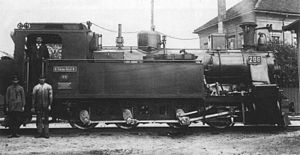Saxon VK
| Kgl.Sächs.Sts.EB - VK DR series 99.61 |
|
|---|---|
| Numbering: | 201-209 99 611-619 |
| Number: | 9 |
| Manufacturer: | Saxon machine factory , Chemnitz |
| Year of construction (s): | 1901-1907 |
| Retirement: | 1934/1942 |
| Type : | D n2vt |
| Genre : | K 44.7 |
| Gauge : | 750 mm |
| Length over coupling: | 8,950 mm |
| Height: | 3,080 mm |
| Width: | 2,170 mm |
| Total wheelbase: | 3,900 mm |
| Smallest bef. Radius: | 40 m |
| Empty mass: | 22.8 t |
| Service mass: | 28.8 t |
| Top speed: | 30 km / h |
| Starting tractive effort: | 43.64 kN |
| Driving wheel diameter: | 855 mm |
| Control type : | Heusinger |
| Number of cylinders: | 2 |
| HD cylinder diameter: | 340 mm |
| LP cylinder diameter: | 530 mm |
| Piston stroke: | 430 mm |
| Boiler overpressure: | 14 bar |
| Grate area: | 0.97 m² |
| Radiant heating surface: | 4.22 m² |
| Evaporation heating surface: | 59.67 m² |
| Water supply: | 2.4 m³ |
| Fuel supply: | 0.96 tons of coal |
As Saxon genus VK ( say : five K) called the Royal Saxon State Railways four-coupled narrow gauge - steam engines , which mainly for Müglitztal train were provided. The Deutsche Reichsbahn classified the locomotives in the 99.61 series from 1925 .
history
For the steeply sloping Müglitztalbahn from Mügeln to Geising - Altenberg , the Sächsische Maschinenfabrik in Chemnitz developed a quadruple coupled locomotive that was supposed to cope better with the operation on this route than the classes IK and IV K previously used . In the years 1901 and 1905 to 1907 a total of nine locomotives were put into service. The examples from 1905 had a slightly larger cab .
The new type of engine with Klien-Lindner axles made it possible to drive through the tight curve radii with a four-fold coupled locomotive, but ultimately the new VK class proved to be just as complicated and maintenance-intensive as the tried and tested IV K.
For this reason, despite the better start-up properties, further procurement of these locomotives was dispensed with.
All nine machines with the numbers 201 to 209 were taken over by the Deutsche Reichsbahn after 1920 and were given the new numbers 99 611 to 99 619 in 1925.
In 1934 and 1942 the locomotives were completely retired. Presumably some locomotives remained in service at the front in one of the theaters of war of the Second World War .
technical features
The dimensions of the boiler corresponded to those of type IV K. The boiler was fed with two Friedmann injectors .
A two-cylinder compound engine , which drove the second coupled axle, served as the steam engine. The low-pressure cylinder on the right was inclined slightly because of its large diameter. The first and fourth coupling axles were designed as Klien-Lindner hollow axles , which required an outer frame with Hall cranks. The hollow axles were jointly adjusted radially using tie rods arranged crosswise.
A vapor brake and throw lever brake were originally provided to slow down the locomotive. The locomotives also had the equipment for the lever brake . The locomotives received the new Körting suction air brake for locomotives and trains as early as 1920 .
The water supply was housed in containers on the side, the coal was in a box behind the driver's cab.
commitment
The six locomotives that were procured were primarily used on the Müglitztalbahn. Even after the appearance of the more powerful VI K , the locomotives stayed on this route. After the Müglitztalbahn was converted to the standard gauge in the 1930s, the locomotives were then also moved to other routes. It is documented that the locomotives are located in Mügeln and Thum as well as on the Taubenheim – Dürrhennersdorf route .
literature
- Wolfgang Wagner, Reiner Scheffler: II K (old), III K and VK as well as third-party locomotives on Saxon narrow-gauge railways. Bufe-Fachbuch-Verlag, Egglham 1996, ISBN 3-922138-60-8 .
- Fritz Näbrich, Günter Meyer, Reiner Preuß: Lokomotiv-Archiv Sachsen 2nd transpress VEB Verlag für Verkehrwesen , Berlin 1984.
